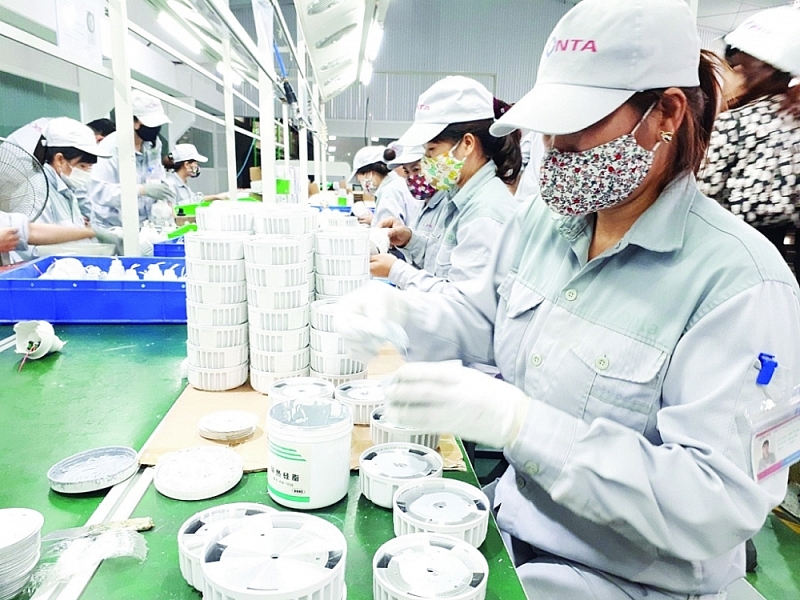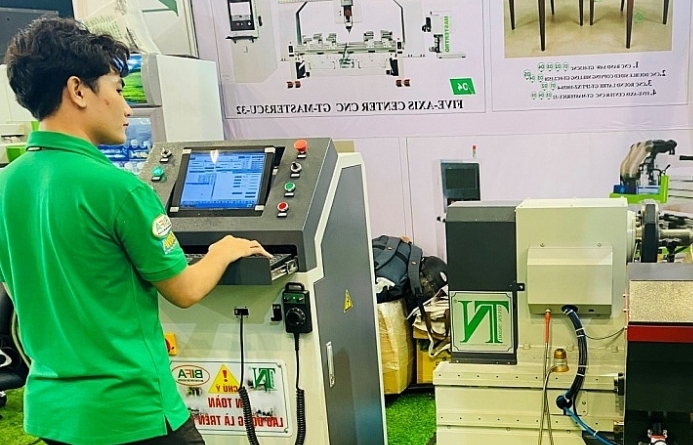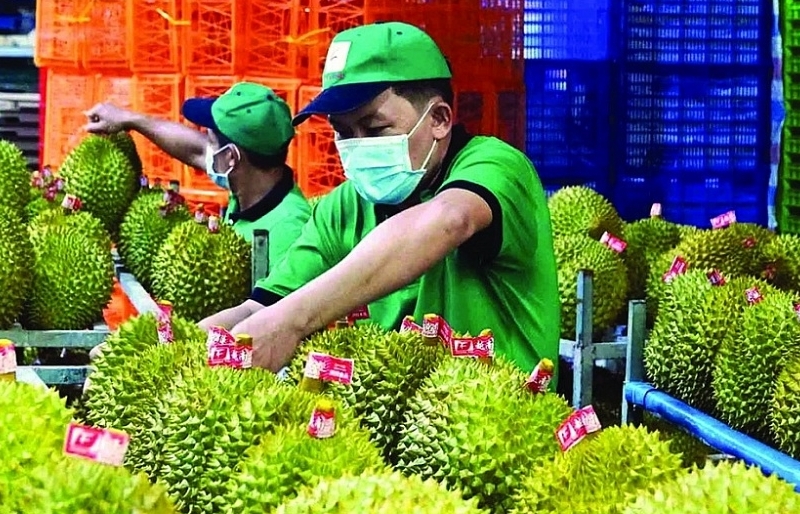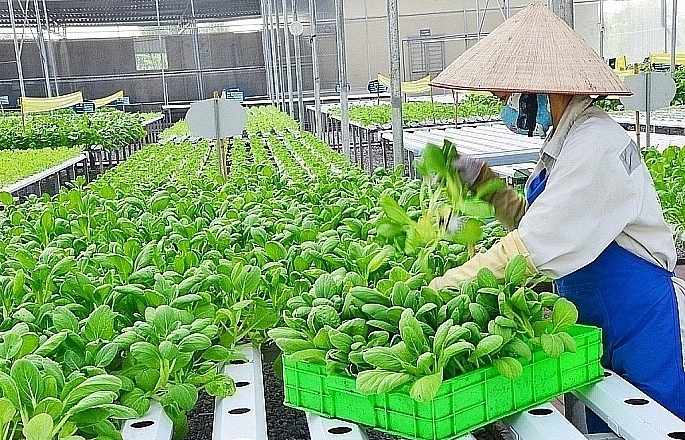Difficulties continue to “lay siege” to industrial production
 |
| From now to the end of the year, the ministry would promote restructuring in fields of industrial production; determining the key task is focusing on the supporting industry. Photo: Nguyễn Thanh |
Textile firms have not received new orders yet
According to the Ministry of Industry and Trade, the industrial production index of July only increased by 3.6% compared to previous month and increased 11% over the same period last year, and did not reach the growth rate of June (industrial production index in June increased 10.3% compared to previous month and increased 7.2% over the same period last year).
Among industries affected by the Covid-19 pandemic from the beginning until now, textiles and garments are quite typical as textile products are mainly for export. If the world market "sneezes", it will cause difficulties for Vietnamese textiles.
The evidence is that export turnover of textiles and garments in the first seven months of the year is estimated at $16.18 billion, down 12.1%; fibers and yarns of all kinds fell by 20.9% compared to the same period in 2019. Notably, as of July, many textile enterprises had almost not generated any orders for the last two quarters of the year for high-value products such as vestons and high-end shirts, while masks and protective clothes are considered "lifesavers" for many garment firms in the second quarter, the current price has plummeted due to oversupply worldwide.
Nguyen Xuan Duong, Chairman of Hung Yen Textile and Apparel Association analysed: "Normally, around July and August, the company would sign a contract to produce spring products from October of the same year to April next year. However, this year, due to the Covid-19 pandemic, the company has not signed any contract. According to preliminary statistics up to now, only large enterprises can reach production capacity in quarter four which is 10%, the rest have not received any orders. This is an alarming problem for the whole industry.”
Through a "slice" of the textile and garment industry and a broad view of the "whole picture" of industrial production, Pham Dinh Thuy, Director of the Department of Industrial Statistics (General Statistics Office) said the reason industrial production from the beginning of the year to now has not grown as expected. That was the complex development of the Covid-19 pandemic in many countries, affecting sources of imported raw materials for industrial production, especially processing and manufacturing. Besides that, Decree No. 100/2019/ND-CP of the Government regulating administrative violations in the road and railway traffic which was effective on January 1, 2020, changed the drinking habits of people, affecting the beverage industry.
Focusing on re-structuring connection chains
From now to the end of the year, not only textiles, many other industries with a high concentration on exports such as leather, footwear, electronics, wood and wood products are forecast to continue to face difficulties.
The Ministry of Industry and Trade analysed that the export value in the first seven months of 2020 of computers, electronic products and components were estimated at $23 billion, up 24.3%; however, mobile phones and spare parts were estimated at $25.65 billion, down 6.6% from the same period last year. It is expected that in the last months of the year, the electronics industry will still strongly affected due to complex developments of the Covid-19 pandemic that can reduce the demand for electronic products in the US and European markets.
With wood processing and wood products, in the context of the Covid-19 pandemic outbreak across the world, the wood industry is affected by the sharp global decline in the demand for furniture. In seven months of 2020, compared with the same period last year, industrial production index of the wood processing industry and manufacturing products from wood, bamboo and manufacturing products from straw and plaiting materials fell 3.4% (while the same period increased 12.9%).
The situation of the export market in the future still lacks prosperity and is difficult to predict, however, according to the finding of reporter, enterprises in the wood processing and exporting industry also expect the disease situation in export markets will be controlled better. Additionally, effective implementation of the Vietnam-EU Free Trade Agreement (EVFTA) will attract more orders.
Nguyen Van Mieng, General Director of Nam Dinh Textile and Garment Joint Stock Corporation, said that to maintain jobs for employees, over time, enterprises have made changes in production structure. If the yarn industry produced 1,100 tonnes, of which 600 tonnes were exported, which means the proportion of exports was 65% previously, yarn exports are only 45% now.
“We compensated for that shortage by expanding the exploitation of the domestic market. In terms of fabric, the corporation is currently producing about 1.2 million metres/month, by the third and fourth quarter of this year, it was likely that we would lose about 230-3 million metres. Therefore, we had expanding the market to the northern provinces, aiming for new product lines and taking advantage of dyed fabric to sell finished products and supply to garment companies,” Mieng stated.
To remove difficulties for industrial production, Minister of Industry and Trade Tran Tuan Anh said that in the last months of the year, the ministry would promote restructuring in fields of industrial production; determining the key task is focusing on the supporting industry.
"Right now, it is necessary to focus on restructuring connection chains to serve industrial production, especially some large Vietnamese processing and manufacturing industries such as textiles, footwear, electronics and furniture towards sustainable direction with some partners such as South Korea, Japan and India avoiding too much dependence on one or a few partners or the market," Minister Tran Tuan Anh said.
Besides that, the head of Industry and Trade also affirmed that the ministry would work closely with a number of multinational FDI enterprises (such as Samsung and Toyota) to strengthen the search for domestic enterprises producing raw materials and accessories that meet production capability to replace imported sources in the short term as well as in the long term; at the same time focusing on processing inventory and maintaining production of materials for production that Vietnam has advantages.
Related News

Removing “bottlenecks” for digital transformation in industrial production
10:00 | 17/12/2024 Import-Export

Imports of textile and footwear materials soar amid robust industry growth
13:44 | 03/12/2024 Import-Export

Supporting industry enterprises: Learning standards, understanding opportunities
09:46 | 13/10/2024 Import-Export

Unique opportunity for businesses in the supporting industry
15:41 | 23/09/2024 Import-Export
Latest News

Nghệ An Province anticipates record FDI amidst economic upswing
15:49 | 26/12/2024 Import-Export

Green farming development needs supportive policies to attract investors
15:46 | 26/12/2024 Import-Export

Vietnamese enterprises adapt to green logistics trend
15:43 | 26/12/2024 Import-Export

Paving the way for Vietnamese agricultural products in China
11:08 | 26/12/2024 Import-Export
More News

VN seafood export surpass 2024 goal of $10 billion
14:59 | 25/12/2024 Import-Export

Exporters urged to actively prepare for trade defence investigation risks when exporting to the UK
14:57 | 25/12/2024 Import-Export

Electronic imports exceed $100 billion
14:55 | 25/12/2024 Import-Export

Forestry exports set a record of $17.3 billion
14:49 | 25/12/2024 Import-Export

Hanoi: Maximum support for affiliating production and sustainable consumption of agricultural products
09:43 | 25/12/2024 Import-Export

Việt Nam boosts supporting industries with development programmes
13:56 | 24/12/2024 Import-Export

VN's wood industry sees chances and challenges from US new trade policies
13:54 | 24/12/2024 Import-Export

Vietnam's fruit, vegetable exports reach new milestone, topping 7 billion USD
13:49 | 24/12/2024 Import-Export

Aquatic exports hit 10 billion USD
13:45 | 24/12/2024 Import-Export
Your care

Nghệ An Province anticipates record FDI amidst economic upswing
15:49 | 26/12/2024 Import-Export

Green farming development needs supportive policies to attract investors
15:46 | 26/12/2024 Import-Export

Vietnamese enterprises adapt to green logistics trend
15:43 | 26/12/2024 Import-Export

Paving the way for Vietnamese agricultural products in China
11:08 | 26/12/2024 Import-Export

VN seafood export surpass 2024 goal of $10 billion
14:59 | 25/12/2024 Import-Export





